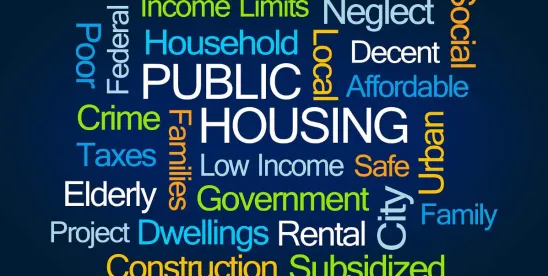Over the past month, the Federal Housing Administration (FHA) has enacted and proposed several changes to its Defect Taxonomy. The Defect Taxonomy is contained in Appendix 8 to FHA Handbook 4000.1. The Defect Taxonomy was originally designed to allow FHA to characterize underwriting related errors in FHA mortgages. Now, if these recent changes are enacted, the Defect Taxonomy will be expanded to address both underwriting and servicing errors. As a result, both originators and servicers of FHA-insured mortgages (mortgagees) should be cognizant of these potential changes. This post provides a brief outline of the enacted and proposed changes to the Defect Taxonomy
Enacted Changes
On July 10, 2024, the U.S. Department of Housing and Urban Development (HUD) issued Mortgagee Letter (ML) 2024-14, expanding mortgagee liability for fraud or misrepresentation to include acts of a sponsored Third-Party Originator (TPO). When possible, FHA expects mortgagees to prevent against fraud or misrepresentation in the origination of an FHA mortgage. If the FHA identifies fraud or misrepresentation, the severity of the fraud or misrepresentation attributable to the mortgagee is characterized in two ways: “Tier 1 (indicating the Mortgagee knew or should have known), or Tier 4 (indicating that the Mortgagee did not know and could not have known).” While ML 2024-14 does not change the relevant tiers, it does expand the concept of what a Mortgagee “knew or should have known.”
Now, pursuant to ML 2024-14, FHA will look to whether “an employee of the Mortgagee or sponsored [TPO] was involved” in the fraud or misrepresentation. Prior to ML 2024-14, the Defect Taxonomy did not address TPOs. Further, the ML states that “FHA will seek life-of-loan indemnification from Mortgagees when there is evidence of fraud or material misrepresentation involving a sponsored TPO.” As a result, mortgagees are now not only effectively liable for the actions of their employees and TPO, but also liable to the same significant degree for any failure on the part of an employee or TPO.
Proposed Changes
On the same day HUD issued ML 2024-14, FHA published a new draft of the Defect Taxonomy seeking feedback through August 26, 2024. The current version of the Taxonomy is divided into five sections: Purpose; Core Concepts; Remedies; Fraud or Misrepresentation; and Underwriting Loan Review. The Underwriting Loan Review section is divided into nine underwriting specific defect areas. If enacted, the proposed Defect Taxonomy will create significant changes, including the addition of a new section of the Defect Taxonomy, Servicing Loan Review, with six defect areas focused specifically on loan servicing.
The proposed changes to the Defect Taxonomy are sweeping and provide much more detail to the existing sections of the Defect Taxonomy, making it more usable for mortgagees. While not all of the revisions to the existing sections can be addressed here, the highlights include:
- Purpose
- Clarifying that FHA uses the Defect Taxonomy “for loan reviews conducted by the Office of Single Family Housing’s Quality Assurance and Processing and Underwriting Divisions,” not for “any type of audit or review separately conducted by HUD’s National Servicing Center, Office of Finance and Budget, or Ginnie Mae.”
- Core Concepts
- Defining both a defect as “any deviation from HUD policy requirements by a Mortgagee or other participant, regardless of severity,” and a Finding as “a determination by FHA of a defect by the Mortgagee;” and
- Providing more detail regarding what generally constitutes a Tier 1, 2, 3, or 4 Finding, including specifying that a Tier 1 or 2 Finding generally aligns “with the definition of a Material Finding (V.A.2.d.i(B)).”
- Remedies
- Specifying that the “purpose of remedies is to mitigate risk to FHA and, if applicable, put borrowers and/or other affected parties in the position they would have been absent the violation;”
- Incorporating a chart of factors FHA uses to determine the term of an indemnification; and
- Adding a new one-year indemnification term that is only applicable in the servicing context.
Additionally, the new Servicing Loan Review section expands the Defect Taxonomy to address servicer deviations from HUD’s policy requirements. In this new section, FHA addresses six specific defect areas:
- Servicer Operations – “Standards and procedures applicable to the servicing of all FHA-insured Single Family Mortgages, including the Servicer’s responsibility for records management, required actions, and various processing functions in the course of mortgage servicing regardless of loan performance.”
- Account Administration – “Standards and procedures specific to the accounting and administrative functions in connection with the servicing of performing FHA-insured Single Family Mortgages, including various routine activities and related reporting, disclosures, and documentation requirements.”
- Delinquent and Default Servicing – “Standards and procedures applicable to the servicing of non-performing FHA-insured Single Family Mortgages, including the Servicer’s responsibility for records management, accounting, and administrative functions, required actions, and various processing functions in the course of delinquent and default mortgage servicing.”
- Loss Mitigation Processing – “Standards and procedures applicable to loss mitigation processing, review activities, required reporting, communications, and financial evaluation for all available loss mitigation alternatives to foreclosure.”
- Home Retention – “Compliance with standards and requirements for various Home Retention Options from processing through completion of related servicing activities. Minimum property acceptability and eligibility standards for FHA insurance, including program and product-specific variations.”
- Home Disposition – “Compliance with standards and requirements for various Home Disposition Options and includes foreclosure processing through property conveyance, claims, and other related matters.”
Within each of these defect areas, FHA provides examples of what constitutes a Tier 1, 2, 3, or 4 Finding and potential remedies for each Tier Finding.
Takeaways
Taking all of these changes together, mortgagees will arguably benefit from the expansion and clarification of the Defect Taxonomy because it provides them with a more detailed understanding of how FHA views potential violations of HUD requirements and the potential remedies to expect for such violations. Additionally, mortgagees should carefully review and consider the proposed changes that implement the new servicing-specific defect areas to determine how these changes would impact their business and whether they should provide comments before the August 26, 2024 feedback deadline. Regardless of whether these changes are enacted, mortgagees should use the information and language in the Defect Taxonomy to guide their conversations with FHA or HUD regarding their origination and servicing practices.





 />i
/>i

